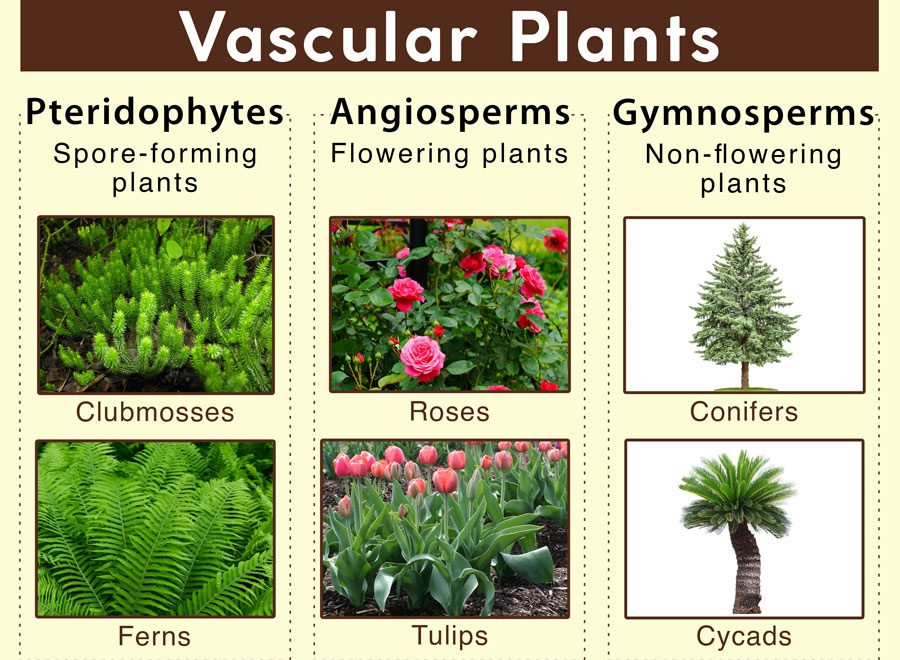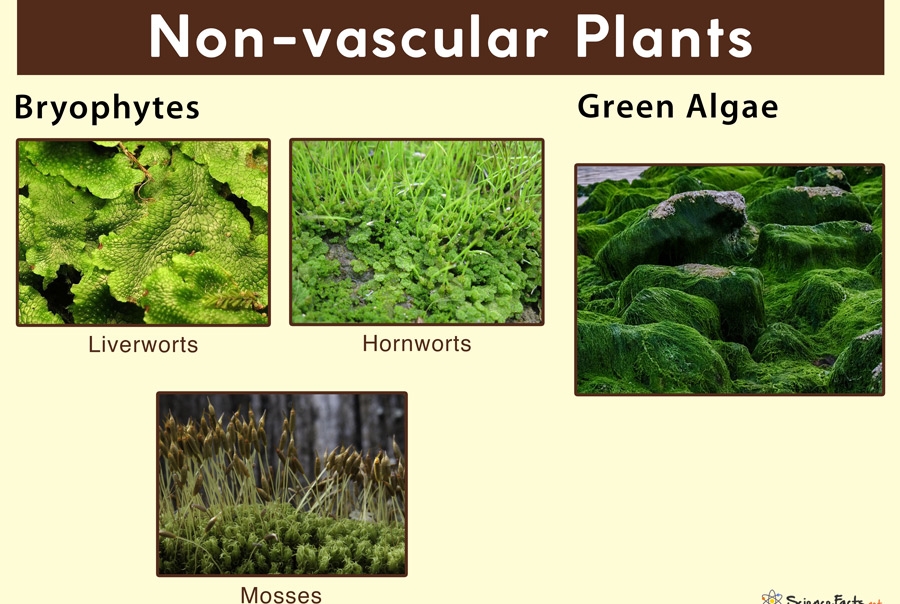Vascular and Non-Vascular Plants
Vascular plants (from Latin vasculum ‘duct or container’) have vascular tissues called xylem and phloem for conducting water and minerals, and conducting food respectively.
Vascular plants are also called tracheophytes that have lignified tissues called xylem is composed of non-living cells (tracheids and vessel elements) and specialized non-lignified tissue called phloem.
Examples: ferns, seed plants, angiosperms, and gymnosperms.
Characteristics of Vascular Plants
- Vascular tissues: Such plants have vascular tissues (xylem and phloem) which distribute resources throughout the plant. The combination of one xylem and one phloem strand adjacent to each other is known as a vascular bundle. The vascular tissue in plants allowed them to evolve to larger sizes than non-vascular plants, which lack these specialized tissues and are being of relatively small sizes.
- Xylem and phloem: These tissues play role in the conduction processes within plants. Sugars are conducted throughout the plant in the phloem, whereas water and other nutrients through the xylem.
- Principal phase: In vascular plants, the principal generation phase is the sporophyte which produces spores and is diploid; while, in non-vascular plants, principal generation phase is the gametophyte which produces gametes and is haploid.
- Vascular plants have true roots, leaves, and stems, even if some groups have secondarily lost one or more of these traits.
- Nutrient Distribution: Water and nutrients from the soil in the form of inorganic solutes are transported throughout the plant by the xylem. Whereas organic compounds such as sucrose produced by photosynthesis in leaves are distributed by the phloem or phloem sieve tube.
- In addition to vascular tissue, the aerial body is covered with a well-developed waxy layer (cuticle) that decreases water loss. Gases are exchanged through stomata in the outer cell layer (epidermis).

Classification of Vascular Plants
The kingdom Plantae is divided into two main subgroups known as vascular plants and non-vascular plants.
- Division Thallophyta: It consists of those plants which reproduce through various kinds of spores, gametes, and in some cases with both. Moreover, these plants either have no or less differentiated vegetative organs (multicellular or unicellular).
Examples: lichens, algae, and fungi. - Division Embryophyta(Archegoniatae): The reproduction mode in these plants is oogamy (a form of sexual reproduction in which female gamete is larger and often non-motile compared to male gametes). This reproduction mode is accompanied by the formation of an egg that develops into a zygote and then embryo to grown adult plant. These plants have true leaves, stems, roots, and flowers.
Subdivision Tracheophyta (Vasculares)
Tracheophytes are vascular plants with stem, leaf, roots, and vascular bundles (xylem and phloem). The sporophytes live an independent life and eventually reduces to obliteration. They are divided into the following types:
- Pteridophyta: It consist of around 1200 species of ferns and non-flowering plants. Such plants are seedless and incapable of transferring the genetic material to their offspring using fruits, seeds, and cones. However, these plants contain spores on the underside of leaves which produce spores known as sporophylls. Pteridophytes’ anatomical structure is diversified such as, leaves remained coiled until they get matured (called fronds), stems are called rhizomes (horizontal) and standard roots with a vascular system. The habitat includes terrestrial, aquatic, cold, and humid areas with preferences in tropical regions.
- Angiosperms: It is most diversified phylum that contains 260,000 flowering vascular plant species. The plants included in phylum angiosperms are shrubs, bulbs, parasitic plants (epiphytes), trees, herbs, and other plants living in freshwater and marine habitats. The popular and largest plant families are orchids (Orchidaceae), legumes (Fabaceae), and daisies (Asteraceae). Apart from the presence of a vascular system in these plants, other characteristics are presence of seeds (in the flower or fruit), formation of endosperm through double fertilization, presence of pollen sacs in the male reproductive tissues.
- Gymnosperms: These plants are widely distributed throughout the world but more abundant in Arctic and Temperate regions. These plants are hemlocks, firs, and pines with similar characteristics such as needle-like leaves and big wood stems. The seeds of these plants are naked as not enclosed by flower or fruit. Instead, they possess cones (strobilus) for reproduction purposes. These plants produce two types of cones i.e., male, and female cones with a difference of size–the female cones are larger than male cones.
Importance of Vascular Plants
Seedless vascular plants
- Food resources: Provides food resources to animals and humans.
- Economic Importance (source of medicine, food, clothing fibre, and wood): The leaves or fronds are used as ornamental plant and for decorating homes. Angiosperms are a good source of medicine, food, clothing fibre, and wood. These angiosperms are economically beneficial for humans and country as well. In addition, many angiosperms are sources of drugs used to cure various diseases by producing chemicals that are used for medicinal purposes.
Some species of Gymnosperms are edible and are source of food, oil whereas others are used for making medicine, used as ornaments, and other industrial products such as gum, tannins, and vice versa. - Erosion control: The fossils of plants like club mosses, spike mosses, fern-like plants, and quillworts of phylum Lycophyta are the component of coal and prevent erosion.
- The plants of Sphenophyte (horsetails) phylum are found near water with jointed stems and leaves in whorls. The stems of such plants contain silica that helps in washing or cleaning of pots, pans, and scoring.
- Ferns: Ecologically, the ferns provide several benefits like a factor in weathering of rocks, reduction in erosion (due to rhizomes spreading in the soil, prepares the top soil layer, houses nitrogen-fixing cyanobacteria to provide the nutrient for aquatic plants/ferns, and absorb toxins from the soil.
Vascular seed plants
- The vascular plants have two types of seed plants, including gymnosperms and angiosperms.
- Angiosperms: These are basis of terrestrial food chains because they convert solar energy into chemical energy and make glucose through photosynthesis. Thus, Angiosperms are the sources of food for both animals and humans. Besides, they keep the environment clean, increase rainfall in forest areas, and protect soil from erosion.
- Gymnosperms: The needle-like leaves of conifers allow continuous photosynthesis during winters. The seeds and roots of Cycads are used for medicinal purposes such as hypertension, treating rheumatic pain and cold, respectively. In addition, ginkgo plant is used for medicinal purposes in controlling and curing asthma, coughs, urinary and digestive problems.
Differences between Vascular & Non-Vascular Plants
Vascular Plants Non-Vascular Plants Such plants have a vascular system. Do not have a vascular system. In vascular plants, the principal generation phase is the sporophyte which produces spores and is diploid. Principal generation phase is the gametophyte which produces gametes and is haploid. Vascular plants have true roots, leaves, and stems and lignified xylem. Have least specialized tissues and no lignified xylem. The aerial body is covered with a well-developed waxy layer (cuticle) that decreases water loss; while, gases are exchanged through stomata. They have not such specialized tissue to resist water loss or facilitate gas exchange. Roots absorb water passively. Depends on diffusion and osmosis. Example: flowering plants, true ferns, horsetails, conifers, clubmosses. Examples: green algae, Bryophyta, mosses.

Frequently Asked Questions (FAQ)
What are Vascular plants?
Those plants having vascular tissues called xylem and phloem for conducting water and minerals, and conducting food respectively are called Vascular plants.
What is Vascular bundle?
The combination of one xylem and one phloem strand adjacent to each other is known as a vascular bundle.
What are Vascular tissues?
Vascular plants have vascular tissues called xylem and phloem. Water and nutrients from the soil in the form of inorganic solutes are transported throughout the plant by the xylem. Whereas organic compounds such as sucrose produced by photosynthesis in leaves are distributed by the phloem.